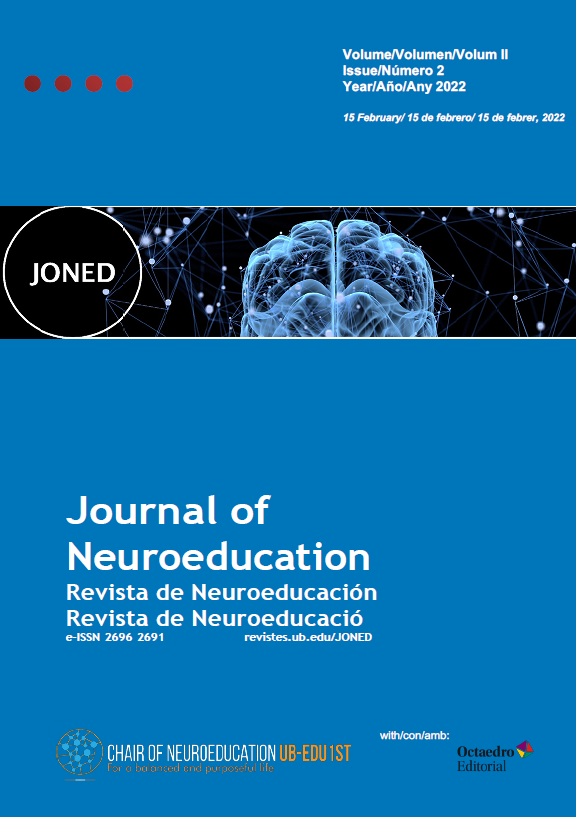Una estructura neurodidàctica per al desenvolupament de les funcions executives en els adolescents
És possible desenvolupar el control inhibitori a l'aula?
DOI:
https://doi.org/10.1344/joned.v2i2.32839Paraules clau:
estructura neurodidàctica, educadors, funcions executives, control inhibitori, adolescentsResum
Existeix un creixent interès per generar pràctiques neuroeducatives que posin el focus en els processos d’aprenentatge dels estudiants amb la finalitat de poder generar canvis en les seves capacitats cognitives i, per tant, facilitar una millora del rendiment acadèmic.
Al llarg d’aquest article es presenta una estructura neurodidàctica dissenyada per al desenvolupament de les funcions executives (FE) en l’etapa adolescent i pensada per a ser incorporada en les diferents matèries escolars, atès que, si es vol incidir en les FE, aquestes han d’estar integrades de manera transversal dins de la competència aprendre a aprendre.
Per a la seva aplicació, es planteja un estudi dividit en tres fases.
Com a conclusió, se argumenta la necessitat de promoure estratègies comunes per a la creació d’aules neuroeducatives que desenvolupin les funcions executives, afavoreixin el bon desenvolupament cognitiu dels adolescents i aportin un canvi de mirada als professionals de l’educació sobre el desenvolupament i les potencialitats de la ment adolescent.
Referències
Blakemore SJ. La invención de uno mismo. Barcelona: Editorial Planeta; 2018. Pág. 31, 78, 109, 115-117.
Jensen FE. El cerebro adolescente: guía de una madre neurocientífica para educar adolescentes. RBA Bolsillo; 2019. Pág. 18, 39-40.
Nin V, Goldin AP, Carboni A. Mate Marote: videogames to stimulate the development of cognitive processes. IEEE-RITA, Feb. 2018, Volume 14, Issue 1. Disponible en: https://www.researchgate.net/publication/333825804_Mate_Marote_Videojuegos_para_Estimular_el_Desarrollo_de_Procesos_Cognitivos
Diamond A, Ling DS. Conclusions about interventions, programs, and approaches for improving executive functions that appear justified and those that, despite much hype, do not. Developmental Cognitive Neuroscience 18. 2016. Pág. 34-48.
Gil JA. ¿Es posible un currículo basado en las funciones ejecutivas? JONED. Journal of Neuroeducation. 2020; 1(1); 114-129. doi: 10.1344/joned. v1i1.31363
Vladisauskas M, Goldin, AP. 20 años de entrenamiento cognitivo: una perspectiva amplia. JONED. Journal of Neuroeducation. 2020; 1(1); 130-135. doi: 10.1344/joned. v1i1.31628
Howard-Jones P. A. et al. Gamification of learning deactivates the default mode network. Frontiers in Psychology 6 (1891); 2016. Disponible en: https://doi.org/10.3389/fpsyg.2015.01891
Stallen M, y Sanfey A. G. Cooperation in the brain: neuroscientific contributions to theory and policy. Current Opinion in Behavioral Sciences, 3. 2015. Pág. 117-121
Bueno D. Neurociencia para educadores. Barcelona: Reference; 2017. Pág. 59-68.
Ballarini F. La sorpresa nos ayuda a consolidar los recuerdos El periódico [Internet]. 2016. [citado el 13 de noviembre 2016/actualizado 27 de noviembre del 2017]. Disponible en: https://www.elperiodico.com/es/cuaderno/20161113/fabricio-ballarini-las-sorpresas-nos-ayudan-a-consolidar-los-recuerdos-5621314
Casafont R. Viaje por tu cerebro: el arte de transformar tu mente. Editorial B, S.A. 2015. Pág. 389-393.
Smink V. Descubren que recibir una sorpresa refuerza la memoria. El BBC Mundo. 2013. [Citado el 22 agosto 2013]. Disponible en: https://www.bbc.com/mundo/noticias/2013/08/130820_argentina_mejorar_memoria_vsgaleria
Flavell JH. Metacognition and cognitive monitoring: A new area of cognitive–developmental inquiry. American Psychologist, 34(10). 1979. Pág. 906–911. doi:10.1037/0003-066X.34.10.906
Price-Mitchell M. Edutopia. Metacognition: Nurturing Self-Awareness in the Classroom. Disponible en: https://www.edutopia.org/blog/8-pathways-metacognition-in-classroom-marilyn-price-mitchell
Golden, C J. STROOP. Test de Colores y Palabras – Edición Revisada (B. Ruiz-Fernández, T. Luque y F. Sánchez-Sánchez, adaptadores). Madrid: TEA Ediciones. 2020.
Montero I, León, OG, Sistema de clasificación del método en los informes de investigación en Psicología. International Journal of Clinical and Health Psychology [Internet]. 2005;5(1):115-127. Recuperado de: https://www.redalyc.org/articulo.oa?id=33701007
Forés A, Gamo JR, C. Guillén J, Hernández T, Ligioiz M, Pardo F, Trinidad C. Neuromitos en el aula. El aprendizaje desde la neurociencia. Plataforma Editorial. 2015. Pág. 11-26.
Baggetta P, Alexander PA. Conceptualization and Operationalization of Executive Function. Mind, Brain, and Education 10 (1). 2016. Pág. 10-33. Disponible en: https://www.researchgate.net/publication/295397594_Conceptualization_and_Operationalization_of_Executive_Function
C. Guillén J. Neuroeducación en el aula: De la teoría a la práctica. 2017. Pág. 34-35, 60.
Castillo-Parra G, Gómez Pérez E, Ostrosky-Solís F. Relación entre las Funciones Ejecutivas y el Nivel de Rendimiento Académico en niños. Revista Neuropsicología, Neuropsiquiatría y Neurociencias. 2009; 9(1), 41-54. Disponible en: http://www.scielo.org.co/pdf/hpsal/v21n2/v21n2a04.pdf
Mora F. Neuroeducación. Solo se puede aprender aquello que se ama. Alianza Editorial. 2019. Pág. 147-156.
Mora F. Mitos y verdades del cerebro. Limpiar el mundo de falsedades y otras historias. Paidós. 2018. Pág. 28-30.
Descàrregues
Publicades
Número
Secció
Llicència
Drets d'autor (c) 2022 Iris Ramos Regalado

Aquesta obra està sota una llicència internacional Creative Commons Reconeixement-NoComercial 4.0.
Els autors que publiquen en aquesta revista accepten els següents termes:
a. Els autors conserven els drets d’autor i d’organisme a la revista el dret de la primera publicació
b. Els textos que es publicaran sota una Llicència d'Atribució No Comercial Creative Commons permeten altres activitats del treball, sempre que inclogui un reconeixement de l’autorització del treball, la seva actualització inicial en aquesta revista i els termes de la llicència, i no se'n faci un ús comercial.



